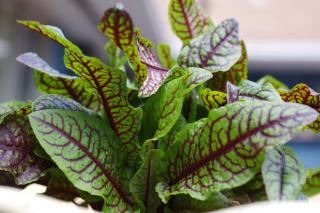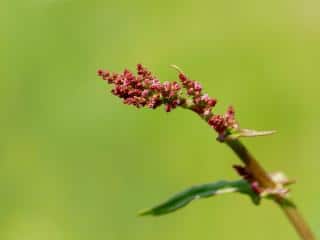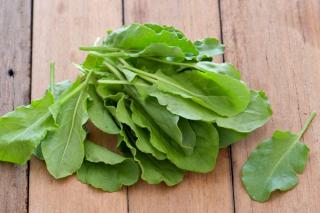

Sorrel is an herb from which leaves are eaten. Their acidic taste is quite distinctive.
Sorrel facts summary
Name – Rumex acetosa
Family – Polygonaceae (buckwheat)
Type – condiment
Height – 10 to 12 inches (25 to 30 cm)
Exposure – full sun, part sun, shade
Soil: cool, rich – Harvest: early summer → early spring (nearly year-round)
Easy to grow, it has the capacity to self-reproduce. You’ll also find it appealing for its many medicinal properties.
Sorrel must be sown in a cool spot where the sun isn’t too strong, it is a plant that will feel at ease in a partially shaded place.
Sorrel can also very well be sown in a pot for a terrace or balcony.
Before sowing sorrel, keep in mind that this plant is very invasive because it propagates very fast.
 Sorrel is sown right at the end of winter with a cover, or in spring directly in the ground.
Sorrel is sown right at the end of winter with a cover, or in spring directly in the ground.
Best select cool and rather rich soil and if possible avoid excessively chalky soil.
Dividing the sorrel clump is the simplest and most practiced manner for propagating your sorrel.
Propagate your sorrel equally well in spring or in fall.
 Dig out the sorrel clump, including as much of the surrounding root system as you can.
Dig out the sorrel clump, including as much of the surrounding root system as you can.Plan to thus split the clumps of sorrel plants that have been in place for 3-4 years, this will regenerate the plant base which tends to weaken with time.
Another option is to let some of the plants go to seed. Then, sow the seeds in spring as detailed above.
Easy to grow and care for, sorrel can be helped with a few good practices to increase the harvest and extend the lifespan of each clump as long as possible.
The first rule is to always keep the sorrel from bolting, or bearing seed.
In pots, sorrel will be even more vulnerable to lack of water, and will need to be watered on a regular schedule, as soon as the surface soil is dry.
Repotting every year is suggested to ensure the plant’s nutrient needs are replenished.

Harvest the sorrel leaves as you need them, first picking the most developed leaves.
Avoid picking leaves that have not yet reached 4 inches (10 centimeters) in size.
The 1st year, wait for at least 3 months after sowing to collect the first leaves.
Sorrel will keep for up to 3 days after picking if you store it in the vegetable compartment of your refrigerator.
Sorrel is also perfect for freezing, and can thus be savored all winter long.
‘Large de Belleville’ – large leaves
‘Blonde de Lyon’ – slow to bolt
‘Sanguine’ – bright red leaves.
Garden patience, Rumex patienta is less acidic.
Sheep’s sorrel, Rumex acetosella, can be found in dry and sandy areas across Europe. Other related species grow in mountain areas, such as French sorrel, Rumex scutatus and maiden sorrel, Rumex alpestris. They can all be used in the same manner as field sorrel.
Since sorrel contains elevated amounts of oxalic acid salts (same as rhubarb), certain patients must refrain from eating this plant. Persons suffering from gout, arthritis, rheumatism and persons often subject to stones must remove it from their diet.
Acidic sorrel is off limits to patients who suffer from ulcers or stomach hyperacidity. However, know that young leaves are much less acidic, and can thus be eaten in moderate amounts from time to time.

Medicinal properties related to treating rheumatism, to enhance digestion have been attributed to it.
There are 4 major sorrel families:
Read also: all our articles and pages dedicated to sorrel.
Cutting the stalks that go to seed is recommended to avoid having the plant spread too far.